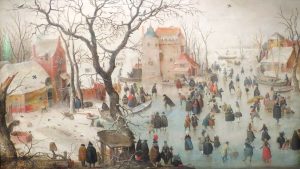Little Ice Age
Climate interval that occurred from the early 14th century through the mid-19th century; the average temperature in the northern hemisphere dropped by just 0.5°C. Advancing glaciers in mountain valleys destroyed European towns. Paintings from the 1600s depict people ice-skating on the Thames River in London and on canals in the Netherlands, places that were ice-free before and after the Little Ice Age.
Scholar disagree about the actual scale and impact of this change. For example, a soldier wrote in his diary while traveling through Germany in 1640 (in August) – At this time there was such a great cold that we almost froze to death in our quarters, and on the road, three people did freeze to death: a cavalry-man, a woman, and a boy. Early studies attributed the European LIA cooling to periods of low solar activity. Later studies suggested a more important role of strong volcanic eruptions in the onset of the LIA, through amplifying internal climate feedbacks, involving a reduced Atlantic meridional overturning circulation (AMOC), and/or a varying phase of the North Atlantic Oscillation (NAO).
Many historical impacts and societal are attributed to Little Ice Age, such as: great famine, black death, 30-year war, midwestern population explosion or even invention of the Bicycle (because people were not able to feed horses with scarce crops).
Painting: Winter Landscape with Ice Skaters, Hendrick Avercamp, c. 1608



 This project (EDU-ARCTIC) has received funding from the European Union’s Horizon 2020 research and innovation programme under grant agreement No 710240. The content of the website is the sole responsibility of the Consortium and it does not represent the opinion of the European Commission, and the Commission is not responsible for any use that might be made of information contained.
This project (EDU-ARCTIC) has received funding from the European Union’s Horizon 2020 research and innovation programme under grant agreement No 710240. The content of the website is the sole responsibility of the Consortium and it does not represent the opinion of the European Commission, and the Commission is not responsible for any use that might be made of information contained.